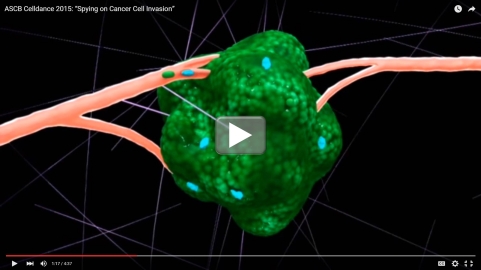02/04/2016 09:00 AM EST

If you’re a fan of the Mission: Impossible spy thrillers, you might think that secret agent Ethan Hunt has done it all. But here’s a potentially life-saving mission that his force has yet to undertake: spying on cancer cells. Never fear—some scientific sleuths already have! So, have a look at this bio-action flick recently featured […]
Cool Videos: Spying on Cancer Cell Invasion
If you’re a fan of the Mission: Impossible spy thrillers, you might think that secret agent Ethan Hunt has done it all. But here’s a potentially life-saving mission that his force has yet to undertake: spying on cancer cells. Never fear—some scientific sleuths already have!
So, have a look at this bio-action flick recently featured in the American Society for Cell Biology’s 2015 Celldance video series. Without giving too much of the plot away, let me just say that it involves cancer cells escaping from a breast tumor and spreading, or metastasizing, to other parts of the body. Along the way, those dastardly cancer cells take advantage of collagen fibers to make a tight-rope getaway and recruit key immune cells, called macrophages, to serve as double agents to aid and abet their diabolical spread.
Produced by M.D./Ph.D. student Edison Leung and research fellow Allison Harney in the lab of John Condeelis at Albert Einstein College of Medicine, New York, this video showcases the power of intravital microscopy (IVM), an extremely high-resolution imaging tool that can monitor cellular and molecular activity in live mice in real time. Although IVM was developed in Germany during the 19th century, the technique never really caught on because when an animal took a breath or made any other small motion, the image shook violently—the visual equivalent of an earthquake! Thanks to modern computer software and Big Data analysis tools, researchers have now developed ways to control for such movement. They have further improved IVM’s scientific utility by incorporating recent advances in tagging biological molecules of interest with fluorescent dyes or other easy-to-visualize probes.
The resulting images have challenged some longstanding ideas about the metastatic process. For example, the Condeelis lab has found that metastasis requires more than one rogue cancer cell: in order for a breast tumor to metastasize, a wayward cancer cell and a macrophage must touch downtogether on a blood vessel. The macrophage loosens the normally tight junction between two blood vessel cells, opening a hole for the cancer cell to squeeze through and enter the bloodstream, facilitating its deadly spread to other parts of the body. Researchers refer to these holes as the tumor microenvironment of metastasis (TMEM).
In a retrospective study of tissue samples from 30 women with localized and metastatic breast cancer, the Albert Einstein group and colleagues determined that TMEM density was greater in samples from women with metastatic disease. In fact, a 10-fold increase in TMEM density correlated with a 90 percent increased risk of metastatic breast cancer [1]. A follow-up study of 500 breast cancer samples also supported the use of TMEMs as a possible prognostic marker for metastatic breast cancer [2, 3]
With all of the biological “espionage” being uncovered in the Condeelis lab and many other institutions around the world, we are on track to devise more strategic ways of attacking metastasis. Take notice, Impossible Missions Force!
References:
[1] Tumor microenvironment of metastasis in human breast carcinoma: a potential prognostic marker linked to hematogenous dissemination. Robinson BD, Sica GL, Liu YF, Rohan TE, Gertler FB, Condeelis JS, Jones JG. Clin Cancer Res. 2009 Apr 1;15(7):2433-41.
[2] Tumor microenvironment of metastasis and risk of distant metastasis of breast cancer. Rohan TE, Xue X, Lin HM, D’Alfonso TM, Ginter PS, Oktay MH, Robinson BD, Ginsberg M, Gertler FB, Glass AG, Sparano JA, Condeelis JS, Jones JG. J Natl Cancer Inst. 2014 Jun 3;106(8).
[3] Study: New Test Predicts If Breast Cancer Will Spread, Albert Einstein College of Medicine Press Release, June 3, 2014.
Links:
Condeelis Lab (Albert Einstein College of Medicine, New York)
Celldance 2015 (American Society for Cell Biology, Bethesda, MD)
NIH Support: National Cancer Institute






















.png)












No hay comentarios:
Publicar un comentario